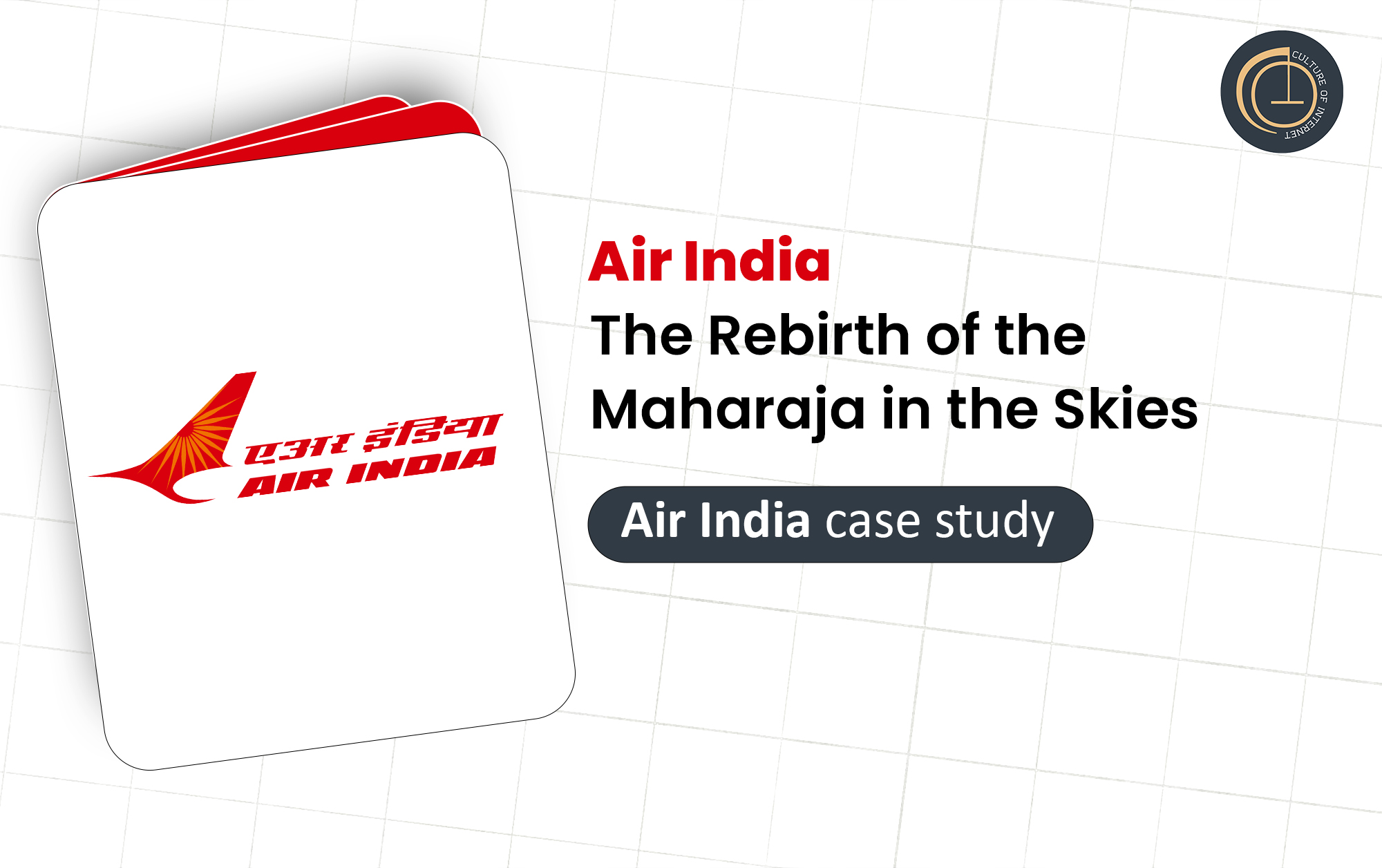Air India: Company Overview
This article traces the full arc of Air India’s history, from its origin story to its future under new leadership, highlighting its unique positioning, milestones, challenges, strategies, and the digital revival that is breathing fresh air into its wings.
Origin and Early Years: The Dream Takes Off:
-
Air India’s story began in 1932 when legendary industrialist J.R.D. Tata, a trained pilot himself, launched Tata Airlines, a division of Tata Sons. On October 15, 1932, J.R.D. flew the first-ever Indian airmail service from Karachi to Bombay via Ahmedabad in a single-engine de Havilland Puss Moth aircraft. This pioneering flight marked the birth of commercial aviation in India.
-
By 1946, Tata Airlines transitioned into a public company and was renamed Air India. In 1948, with a 49% stake from the Government of India, Air India International was launched, making its first international flight from Mumbai to London via Cairo and Geneva, using a Lockheed Constellation aircraft. This made Air India the first Asian airline to offer international service.
Golden Age: Elegance and Excellence in the Skies:
-
The 1950s and 1960s were considered the golden era of Air India. Known for its lavish interiors, impeccable service, and elite clientele, Air India was synonymous with luxury. Passengers were treated like royalty, and the airline became known for its charming mascot—the Maharaja—who added a quirky yet classy personality to the brand.
During this time, Air India achieved several milestones:
-
In 1960, it became the first Asian airline to induct a jet aircraft, the Boeing 707.
-
It expanded to cities like New York, Paris, Nairobi, Tokyo, and Sydney.
-
It was regarded among the top global airlines in terms of hospitality and reliability.
J.R.D. Tata remained closely associated with the airline until 1978, guiding its values and excellence.
Nationalization: The Beginning of Bureaucracy:
In 1953, the Indian government nationalized Air India, turning it into a state-owned enterprise. While this move was aimed at consolidating and strengthening India’s aviation industry, it slowly led to operational inefficiencies, political interference, and lack of accountability.
“Two separate entities were formed”:-
Air India for international flights.
Indian Airlines for domestic routes.
“Over the decades, Air India suffered due to”:-
Overstaffing and mismanagement.
Delayed decision-making and corruption.
Poor financial planning and mounting losses.
Despite maintaining high standards in certain areas, the airline’s quality and customer experience began to decline in the 1990s and 2000s.
The Merger with Indian Airlines: A Rocky Ride:
In 2007, the government decided to merge Air India and Indian Airlines into a single entity to reduce redundancy and improve operational efficiency. The new entity retained the name Air India.
However, this merger proved to be disastrous:
Differences in work culture between the two airlines led to internal friction.
Integration of staff, systems, and unions was poorly handled.
Losses skyrocketed, and service levels dropped sharply.
Between 2007 and 2021, Air India reportedly accumulated over ₹77,000 crore ($10 billion) in losses. It became a burden on the exchequer, surviving only on government bailouts.
Challenges Faced by Air India:
Some of the key issues that plagued Air India for over a decade:
Operational Inefficiencies:-
Frequent delays and cancellations.
Poor aircraft utilization.
Low employee productivity.
Mounting Debt:-
Massive loan interest payments.
Losses from fuel costs, route mismanagement, and unsold seats.
Aging Fleet and Poor Maintenance:-
Lack of investment in new aircraft.
Frequent technical snags affected customer trust.
Declining Brand Image:-
From being a symbol of luxury, it became a case study in mismanagement.
Negative customer reviews and falling loyalty.
The Tata Takeover: A Historic Homecoming:
-
After years of failed attempts at disinvestment, in January 2022, Air India finally returned to its original founder—the Tata Group—after nearly 69 years.
Key Highlights of the Tata Deal:
-
Tata Sons acquired Air India, Air India Express, and a 50% stake in ground-handling company AI-SATS.
-
The acquisition was valued at ₹18,000 crore ($2.4 billion).
-
( Tata assumed part of the airline’s debt and committed to reviving the brand. )
-
This marked not just a financial deal but an emotional reunion, as J.R.D. Tata's vision was being revived by his legacy conglomerate.
Revival and Rebuilding: Tata’s Strategy:
The Tata Group, with its deep business expertise and focus on excellence, began executing a comprehensive plan to restore Air India’s former glory.
Leadership and Governance:-
Campbell Wilson (former CEO of Singapore Airlines’ Scoot) was appointed as CEO.
A fresh management team was brought in with a focus on professionalism and autonomy.
Fleet Modernization:-
A historic order of 540 aircraft (470 from Boeing and Airbus + 70 options) was placed in 2023.
This is one of the largest aircraft orders in aviation history.
Merging Brands:-
Plans to merge Vistara (joint venture with Singapore Airlines) into Air India.
Air India Express and AirAsia India were also brought under one umbrella.
Technology and Digital Transformation:-
Investment in modern reservation systems.
AI-based customer support, real-time flight updates, and revamped website/app.
Enhanced loyalty program integration with Tata Neu (super app).
Customer Experience and Training:-
Revamp of cabin interiors, menu design, uniforms, and lounge services.
Retraining of staff on hospitality and international standards.
Power of Tata Network and Synergies:
Being a part of the Tata ecosystem gives Air India access to world-class resources:
-
TCS is helping in digitization and AI adoption.
-
Taj Hotels is contributing to in-flight food and hospitality standards.
-
Tata Neu is enabling loyalty points and a digital customer base.
This integrated approach is helping Air India reduce costs, increase efficiency, and enhance customer experience.
Air India in Numbers (2025 Stats):
-
Metric Data (2025)
Fleet Size : 140+ (growing with new deliveries)
Employees : 10,000+
Daily Flights : 1,300+ (Domestic & International)
Destinations : 80+ across 5 continents
Global Alliances : Star Alliance member
Market Share (India) : 25% (combined with Vistara & AI Exp.)
Aircraft on Order : 470+ (Boeing & Airbus)
Digital Marketing and Brand Repositioning:
Under Tata, Air India is investing heavily in modern branding and marketing:
Leadership and Governance:-
A sleek new logo inspired by the chakra and golden window frames. New livery in red, gold, and purple, symbolizing modern Indian elegance.
Marketing Focus:-
Emphasis on "New India, New Air India".
Targeting young Indians, global travelers, and diaspora.
Strong presence on Instagram, YouTube, and travel apps.
Partnerships:-
Strategic tie-ups with tourism boards.
Co-branding with Indian festivals, global sports events, and influencers.
Future Plans and Vision 2030:
Air India’s new 10-year transformation roadmap called Vihaan.AI includes:
Becoming a world-class airline with best-in-class safety, comfort, and service.
Achieving global scale, competing with Emirates, Singapore Airlines, and Qatar Airways.
Making Delhi and Mumbai into international aviation hubs.
Focusing on sustainability with new fuel-efficient aircraft and carbon-neutral goals.
Conclusion: A Maharaja Reborn:
Air India’s journey is a powerful reflection of India’s evolution—starting as a bold dream, losing its way in bureaucracy, and now rising again with entrepreneurial zeal. Under the Tata Group, the airline is regaining trust, investing in excellence, and building a future that resonates with global aviation standards.
The Maharaja, once seen as a tired relic of the past, is smiling again—charmingly welcoming passengers aboard a reborn airline that promises dignity, delight, and a destination beyond just miles.As the skies open up post-pandemic and competition heats up globally, Air India has both a historic responsibility and a renewed opportunity—to soar not just as India’s flag carrier, but as a global ambassador of Indian hospitality.
Explore Our Comprehensive Marketing Strategy Course
Join our in-depth course to master Air India India's marketing strategies, learn from expert case studies, and gain actionable insights to apply in your own business or career.









